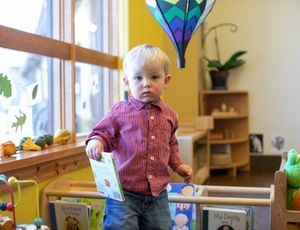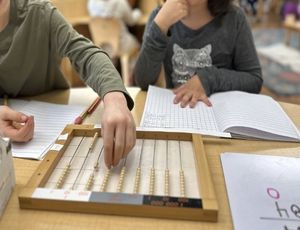It has been a few weeks since your newborn made his debut in this world and the process of understanding his needs can take many more weeks. The best tool you can use to identify his needs is an objective observation. Only then will you start to recognize patterns and different ways your baby expresses himself using his body movements, gestures and sounds. This month we will talk about why and how babies develop a sense of trust in the world when their needs are met during the symbiotic period.
Dr. Montessori talked about “Two Basic Trusts” the child can develop during the first year of life. The first one is trust in the environment, and the second is trust in himself. In this article, we will look into developing trust in the environment since it is usually acquired by the end of the second month of life; this is when the mother and the child depend on each other to satisfy physical and psychological needs.
When parents respond appropriately to the child’s signals with abundant comfort, nurturance, and security, the child establishes a relationship of trust with the environment. He learns that the external world responds promptly to his needs for contact, stimulation, and food because there is always an answer to his call. He can trust the environment, which is now represented by the mother.
Daily, there are many opportunities to nourish the trust the child is building towards the environment through three different modes of contact:
- Holding: The simple act of holding the child in our arms can vary greatly. Everything depends on our feelings towards him because our body contact tells the child about the acceptance and attitude we have. When this is positive, it provides great reassurance to him, facilitating his transition into the new environment.
- Handling: This refers to the way we use our hands when bathing, changing a diaper, dressing, and talking to him. When parents use their hands for affectionate exchanges with the child, they become an occasion for him to gain knowledge about himself and the surrounding world.
- Feeding: Breastfeeding is a vital part of the attachment required at this time because when the child is breastfed on demand and carefully held, his need for food and direct contact with his mother are met. If for any reason the mother is unable to breastfeed, she can still spend plenty of time carefully holding her child and still satisfy the need for direct contact with her. When feeding your child, be present, observe, talk to your baby, and remove any distractions such as cellphones, television and tablets.
By the end of the first eight weeks of life, the symbiotic period comes to an end, along with the period of adaptation to his new world. A child who trusts in the external environment will approach life with optimism and security. He will know that the world is a beautiful place and that no matter how difficult circumstances become, that external help can always be found and he will be able to thrive.
This does not mean it is only the responsibility of the mother to devote all efforts and care during this period. The father or another primary support person also has an essential role; supporting and protecting the mother from unnecessary strain, loving and caring for her, participating in handling the baby, changing diapers, dressing and bathing with care are some of the ways they can be an active part of building this trust.
Item of the Month
Movement Mat
A movement mat is a soft mattress, blanket, or cushioned rug placed next to a shatterproof mirror either mounted to the wall, or that stands horizontally on the movement mat. The child will spend lots of time on this movement mat during the day; it allows him to see everything in the room and move freely. A few rattles can be placed next to the child. At first he will be able to look at them; later on, as he starts controlling his arms, he will be able to manipulate them. This is also a great space to hang Montessori mobiles above the child for him to observe.
Here is a suggestion for how to create your own movement mat:
https://www.freeandunfettered.com/montessori-create-an-infant-play-space-at-home/
Looking for a Montessori School?
The word Montessori was never copyrighted, and because of this, anybody can use it regardless of the level of knowledge and understanding they might have of the philosophy and practices Dr. Maria Montessori developed. That’s why we listed eight different things to look for when touring Montessori schools:
- They have multi-age groups: The groups have mixed ages, from 2 months to 18 months for Nido, 18 months to 36 months for the Toddler Community, 3 to 6 years in the Children’s House, and 6-9 years and 9-12 years for the Elementary level. The older children model and help the younger children.
- All furniture in the environment is child-sized: tables, chairs, and shelves are the child’s height.
- There are beautiful, concrete materials on the shelves, and children can touch, explore, and work with them.
- There are natural elements inside the environment. Plants, small trees, and live animals should be part of the community.
- From 18 months and on, the daily schedule has a segment dedicated to an uninterrupted work cycle. During this time, children have the freedom to choose and work with the materials available in the environment without any interruptions from the outside.
- The work and progress of children are not measured by grades or report cards.
- The atmosphere of the environment, in general, is of calmness. The teacher talks respectfully to each child, and there should not be any yelling. The children are happy and work independently.
- If you believe Montessori is the best option for your child, look for a recognized Montessori program. Both the Association Montessori International (AMI) and the American Montessori Society (AMS) have high standards and certified teachers.



